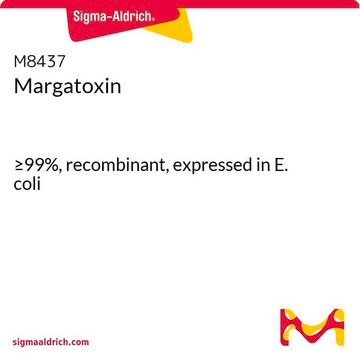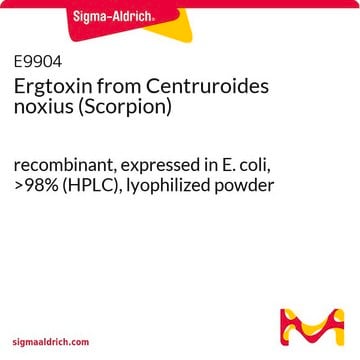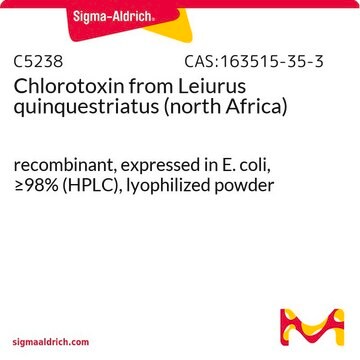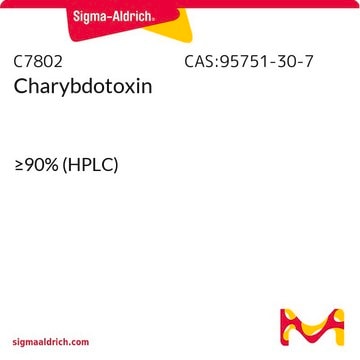V5251
Scorpion venom from Leiurus quinquestriatus (north Africa)
Sinónimos:
Deathstalker
Iniciar sesiónpara Ver la Fijación de precios por contrato y de la organización
About This Item
UNSPSC Code:
12352200
NACRES:
NA.77
Productos recomendados
Quality Level
storage temp.
−20°C
General description
Note: This venom is distinguishable from L.q. hebraeus (V1755) electrophoretically. This may be due in part to the presence of ToxinV in the North African venom.
Application
Scorpion venom from Leiurus quinquestriatus (north Africa) has been used to monitor stimulation levels and to test its effect on receptor responses in slowly adapting (SA) abdominal stretch receptor neurons. It has also been used to test its effect on γ-aminobutyric acid (GABA) release in the isolated synapse of crayfish.
Biochem/physiol Actions
Scorpion venom from Leiurus quinquestriatus has high levels of zinc and manganese. It elicits harmful effects and is reported to induce cytotoxicity and enhance apoptosis in cancer cell lines.
Storage Class
11 - Combustible Solids
wgk_germany
WGK 3
flash_point_f
Not applicable
flash_point_c
Not applicable
Certificados de análisis (COA)
Busque Certificados de análisis (COA) introduciendo el número de lote del producto. Los números de lote se encuentran en la etiqueta del producto después de las palabras «Lot» o «Batch»
¿Ya tiene este producto?
Encuentre la documentación para los productos que ha comprado recientemente en la Biblioteca de documentos.
Nuhan Purali
Toxicon : official journal of the International Society on Toxinology, 41(3), 383-389 (2003-02-05)
Effects of various types of scorpion venom on gamma-aminobutyric acid (GABA) release were studied in an isolated synapse in the crayfish. Post-synaptic GABA-induced currents were recorded to monitor the GABA release from the pre-synaptic site. In 20mM tetraethylammonium (TEA) chloride
N Purali
General physiology and biophysics, 21(2), 205-226 (2002-09-19)
Action potentials (APs) and impulse responses in the soma and axon of the rapidly and slowly adapting (SA) abdominal stretch receptor neurons of the crayfish (Astacus leptodactylus) were recorded with single microelectrode current-clamp technique. Impulse frequency response to constant current
AbdulRahman K Al-Asmari et al.
Journal of venom research, 7, 16-20 (2016-11-09)
Scorpion venom is a rich source of biomolecules, which can perturb physiological activity of the host on envenomation and may also have a therapeutic potential. Scorpion venoms produced by the columnar cells of venom gland are complex mixture of mucopolysaccharides
Morphology, histology, histochemistry and fine structure of venom apparatus of the medically relevant Scorpion, Leiurus quinquestriatus
Bioscience Reports, 12(2), 1274-1288 (2020)
Nuestro equipo de científicos tiene experiencia en todas las áreas de investigación: Ciencias de la vida, Ciencia de los materiales, Síntesis química, Cromatografía, Analítica y muchas otras.
Póngase en contacto con el Servicio técnico








